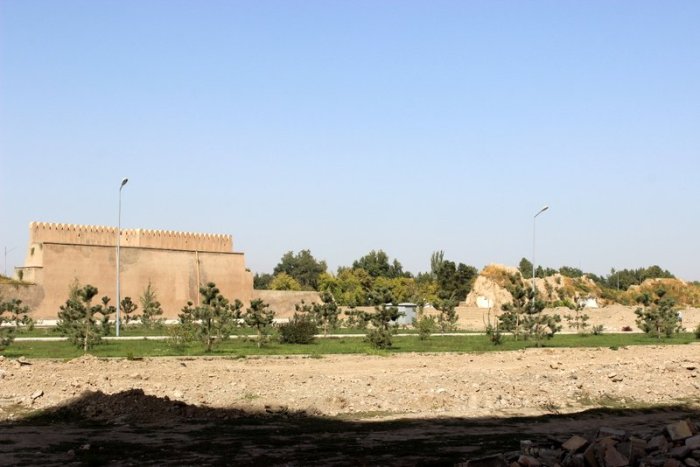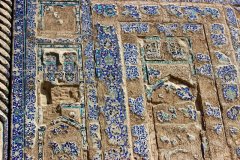I arrived in Shakhrisabz after a 4-hour, uneventful ride from Bukhara. It was the first day of a 3-day public holiday in Uzbekistan for Qurban Hayit (or Bakri Id as we know in India) and the town appeared to be quite deserted.
Though I knew that the monuments would be open and my guide waiting for me, it was still a little unnerving to see empty streets and closed shops as my car drove into the town shortly before noon. I was surprised to see so few tourists in Shakhrisabz, especially considering the fact that it, or rather its historic city centre, is a UNESCO World Heritage Site (inscribed in 2000). The harsh sun only accentuated the emptiness, as did a lack of green cover, which was ironical as I found out later that “Shakhrisabz” means Green City in English !

When I met Tursonay, my guide, one of the first questions I asked her was why there were so few people on Shakhrisabz here. Her answer was quite crisp and to the point: Shakhrisabz was not as grand or glamorous as Samarkand or Bukhara. But, she went on to add, the history of the region would have been very different if not for the most famous son of Shakhrisabz — Timur, Uzbekistan’s national hero. And for that reason alone, Shakhrisabz was important,
And over the next 2-3 hours that hot September afternoon in 2015, I got introduced to Amir Timur — as he is referred to in Uzbekistan — and got acquainted with his home town, Shakhrisabz.
Shakhrisabz was known as Kesh in ancient times and with remains of a settlement dating back to 2,700 years old having been found in the area, this is also one of Central Asia’s oldest cities. It has been part of the Achemenid Empire (6th to 4th centuries BCE), and Sogdian Empire in the (6th-7th century CE) before being conquered by the Arabs in 710.
It had always been an important town, a pit stop, on the trade route through the region, and would have continued to remain as one if not for the birth of its most famous son, Amir Timur, in 1336. Though Timur traveled far for his military conquests and made Samarqand the capital of his empire, his home town was not forgotten. He fortified the town, developed it, renamed it and built a magnificent palace, the Ak Sarai there. After his death, Shakhrisabz never rose to prominence again and was sacked by the emir of Bukhara in the 1700s. With the coming of the Russians, it fell further into neglect.
It is only with the independence of Uzbekistan in 1991 and the declaration of Amir Timur as the country’s national hero did attention fall on Shakhrisabz and its much neglected Timurid monuments — the Ak Sarai Palace, Kok Gumbad, Dor-ut Tilovat Complex, Dor-us Siyodut, and Timur’s crypt. Therein began some rather aggressive and over zealous renovation, and except for the Ak Sarai none of the other monuments have been spared. The process is still on and scaffolding can be seen everywhere in the monuments.
Presenting the monuments of Shakhrisabz. Clicking on any of the photographs in each set will enlarge it. You can then use the left or right arrow keys to navigate the photographs and their accompanying captions.
One thing that I found very impressive at the monuments in Shakhrisabz was the external tile work. The patterns, the colours, the designs and the calligraphy were simply breathtaking. That most of it was in ruins only underscored how brilliant they would have looked like when intact !
Presenting details from the tiles at the monuments of Shakhrisabz. Clicking on any of the photographs in each set will enlarge it. You can then use the left or right arrow keys to navigate through the photographs.
All through the guided tour, Tursonay kept narrating snippets from Timur’s life — his keen military sense, his love for the arts and science, his habit of “collecting” intellectuals, thinkers, philosophers from all over, his appreciation of culture, and so on. It was difficult to reconcile the image I had of him from my school books and books written by Western authors as a ruthless and merciless conqueror, a barbarian, etc.
Shakhrisabz may not have had the charms of the other places I visited in Uzbekistan, but it surely gave me a lot to think about in the way history is taught, viewed and perceived, particularly with reference to Amir Timur and the Timurid dynasty.

After a late and delicious lunch of bread, salad and coca-cola (!), it was time to leave for Samarqand, where the story of Timur and his dynasty would continue.
The road to Samarqand was an ancient trade route that cut through the Zarafshan mountains and is a well maintained highway today. What would have taken the caravan a week or more to cover the 90-odd kilometres, took me just two hours and to another beautiful part of Uzbekistan.
My Dream Trip Uzbekistan Series:
Dear Uzbekistan | A city called Nukus | Art in the Desert: The Savitsky Collection at Nukus | Mizdahkan: A city for the dead | 3 forts & a dakhma | Itchan Kala of Khiva | There’s something about Bukhara! | Monumental Bukhara | The Jewish Heritage of Bukhara | Shakhrisabz: The home town of Amir Timur | The Registan Square of Samarqand | The blue city of Samarqand | The silk paper factory at Konigil | The surprise & delight that was Tashkent | Uzbekistan: The food & markets special | The Uzbekistan trip planner |
Join me on Twitter, Facebook and Instagram as I share all “My Favourite Things” with you.



























The art work on the monuments is indeed amazing.. So blue.
LikeLiked by 1 person
Blue is the predominant colour in tile work across Uzbekistan. Since you have been following the entire series, you would have noticed how the blue has changed from a deep cobalt blue in Khiva to a lighter blue in Bukhara to this shade in Shakhrisabz.
The zenith of blue tile work is in Samarkand as you will see in a forthcoming post. It is absolutely stunning there.
LikeLiked by 1 person
“It was difficult to reconcile the image I had of him from my school books and books written by Western authors as a ruthless and merciless conqueror, a barbarian, etc.”
Thanks especially for this quote. Too often we neglect or ignore primary- and native-source content in favor of cutter cookie text book material.
Lovely blogpost! Once again, you’ve inspired me to visit a place not on my (rather long) list of destinations.
LikeLiked by 1 person
Thank you, Anon. I love how you get to the heart of the post so beautifully; most readers seem to miss it completely. I wish history was not taught from state prescribed textbooks, but from the reading of many histories of a period, a dynasty, a civilisation. The more I read about Amir Timur and Ulugh Beg as well, the more I become aware of the prejudiced portrayal in our part of the world.
By the time I finish writing this series (there are 4-5 posts left), I hope that I succeed in pushing your visit to Uzbekistan at the top of your list. 🙂
LikeLike
So interesting!!
Yes, history is lot to do with subjective perspective of scholars!!
LikeLiked by 1 person
And it is also this subjective perspective and refusal to accept multiple viewpoints that is cause of so many problems today.
My visit to Uzbekistan has also led me to unlearn some parts of history and learn some new perspectives. This is the best thing about travel. 🙂
LikeLike
Timur may be a national hero in his home country. But from Indian perspective we can not forget the crimes against humanity that his forces committed in India. Travelers perspective is another perspective where he/she see sees everything from a neutral perspective. The magnanimous monuments, intricate tile works still contain the blood mark of innocent civilians of India and their looted wealth
LikeLike